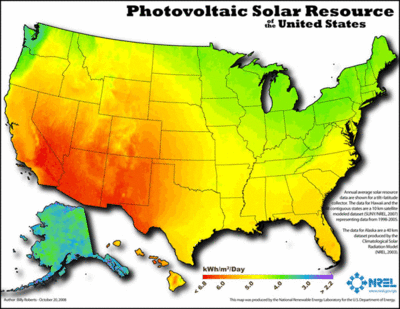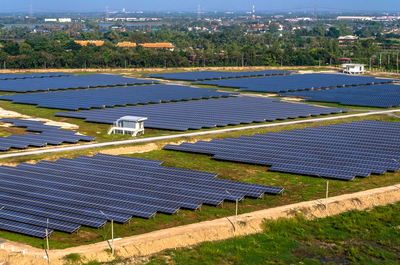Solar Power
Introduction
There are three basic ways in which solar energy is converted into forms which are useful. Two of them, photovoltaics (PV) and concentrating solar power (CSP), can be used for the generation of electricity. The third, low-temperature solar collection, simply absorbs the heat energy of the sun and uses that directly for heating purposes.
Resources

Sunlight is the single resource for all of solar energy. However, the amount of sunlight available varies with the time of year, the time of day, and location. For example, some parts of the U.S. are sunnier for greater parts of the year than other areas. In addition, the mechanisms used to gather the energy of the sun can affect the efficacy with which sunlight can be harvested.
Photovoltaic
Concentrated
Variability
Solar power depends on the sun. Nighttime is dead time for all methods of generating solar power. Variability of sunlight on cloudy days diminishes the energy that can be gathered by any solar method currently available. So what can be done to provide power to the grid during night or under cloudy conditions? There are several possible approaches to this challenge.
Environment
The principal driving force for adoption of solar energy as the primary source for heating and electricity is its non-generation of greenhouse gasses, thus reducing its negative impact on the environment to almost zero. In addition, the gathering of solar energy does not contaminate waterways.
The only negative effects of solar energy on the environment are confined almost entirely to the location where solar collectors are installed to receive solar radiation from the sun. Commercial solar farms require the clearing of sizable areas to install arrays of solar collectors. Furthermore, some negative impact is possible on the animals and birds that populate the solar farm locale.
Economics

(click image to enlarge)
The economic viability of solar power or power from any other renewable energy source depends on the use requirements, market forces, and governmental policies (e.g. mandates or subsidies) that determine the profitability of each particular installation. It is important to distinguish between solar-based, utility power plants, designed to produce electricity for the grid, and residential applications, such as installations of solar panels on the roofs of homes. The types of installations discussed in this section are solar power plants designed to convert sunlight to electricity for feeding to the electrical grid. For residential applications, see our "USES->HOMES++" section.